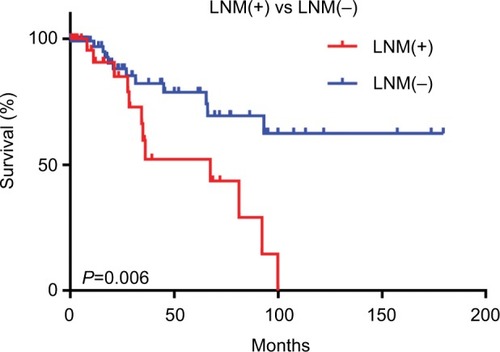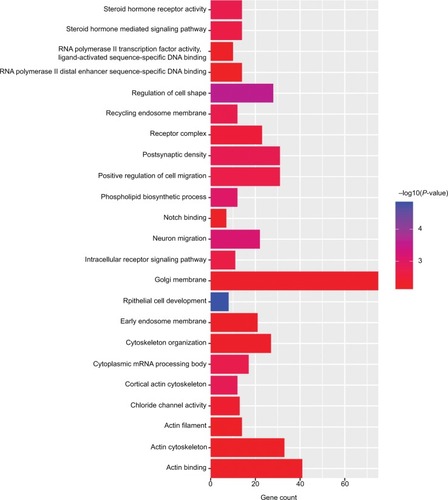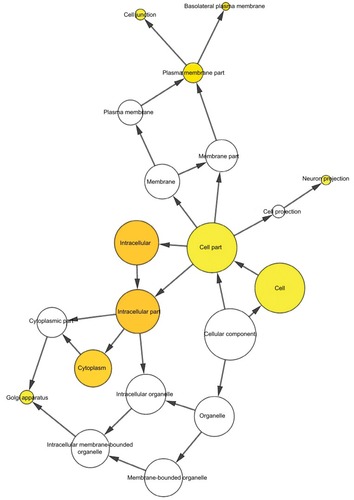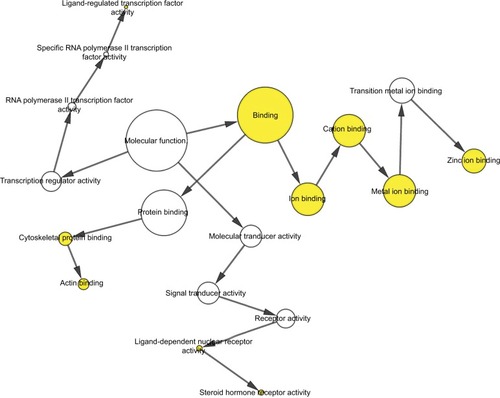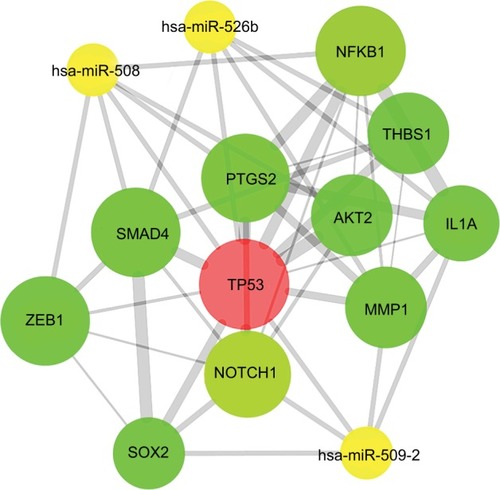Abstract
Background and aim
Previous studies have suggested that lymph node metastasis (LNM) in early-stage cervical cancer (CESC) may affect the prognosis of patients and the outcomes of subsequent adjuvant therapy. However, research focused on miRNA expression in early-stage CESC patients with LNM remains limited. Therefore, it is necessary to identify prognostic miRNAs and determine their molecular mechanisms.
Methods
We evaluated the differentially expressed genes in early-stage CESC patients with LNM compared to patients without LNM and evaluated the prognostic significance of these differentially expressed genes by analyzing a public dataset from The Cancer Genome Atlas. Potential molecular mechanisms were investigated by gene ontology, the Kyoto Encyclopedia of Genes and Genomes, and protein–protein interaction network analyses.
Results
According to the The Cancer Genome Atlas data, hsa-miR-508, hsa-miR-509-2, and hsa-miR-526b expression levels were significantly lower in early-stage CESC patients with LNM than in patients without LNM. A multivariate analysis suggested that three miRNAs were prognostic factors for CESC (P<0.05). The target genes were identified to be involved in the MAPK, cAMP, PI3K/Akt, mTOR, and estrogen cancer signaling pathways. Protein–protein interaction network analysis showed that TP53, MMP1, NOTCH1, SMAD4, and NFKB1 were the most significant hub proteins.
Conclusion
Our results indicate that hsa-miR-508, hsa-miR-509-2, and hsa-miR-526b may be potential diagnostic biomarkers for early-stage CESC with LNM, and serve as prognostic predictors for patients with CESC.
Introduction
Cervical cancer (CESC) is one of the leading etiologies of malignant tumor deaths in woman aged 20–39 years. According to the National Center for Health Statistics, in 2017, there were 12,820 estimated new cases of CESC and 4,210 estimated deaths caused by CESC in America.Citation1 In fact, CESC deaths in developing countries account for 90% of the world’s total death toll, causing severe public health problems and financial burden.Citation2 Some studies have shown that miRNAs are associated with the development and prognosis of CESC.Citation3–Citation5 Previous studies have reported that lymph node metastasis (LNM) in early-stage CESC influences the patient’s survival and outcomes of subsequent adjuvant therapy, but there is limited research on the relationship between LNM and miRNAs in early-stage CESC.Citation6–Citation9 Therefore, it is meaningful to study the molecular mechanisms of CESC and identify miRNA markers for individualized treatment plans and prognostic prediction of CESC. miRNAs are small noncoding RNAs of ~22 nucleotides in length that play regulatory roles in RNA silencing.Citation10
miRNAs are involved in regulating 30% of human genes.Citation11 Through the regulation of target genes, miRNAs play a role in cell cycle regulation, cell proliferation, apoptosis, drug resistance, and other biological processes (BPs).Citation12–Citation17 Additionally, miRNAs are stable in tissue, blood, and urine.Citation18–Citation20 Therefore, miRNAs show promise for use in the diagnosis and treatment of CESC.
The Cancer Genome Atlas (TCGA) contains genomic and proteomic data from more than 20 tumor types, with the benefits of a large sample size, a unified testing platform, and complete follow-up information; moreover, an increasing number of studies utilize data from this database.Citation3,Citation5,Citation21–Citation23 High-throughput dataset analysis may provide a useful method for the identification of hub genes and patterns in CESC. In this study, we analyzed the differences in miRNA expression patterns between early-stage CESC patients with LNM [LNM(+)] and without LNM [LNM(−)]. Additionally, we analyzed the prognostic value of these miRNAs (hsa-miR-508, hsa-miR-509-2, and hsa-miR-526b) and their possible mechanisms of action, which may offer new insight for improving CESC treatment and patient survival. Based on our results, hsa-miR-508, hsa-miR-509-2, and hsa-miR-526b may be potential diagnostic biomarkers and prognostic indicators of CESC.
Materials and methods
CESC patients in TCGA
The information and miRNA data for 307 patients with CESC were obtained from the TCGA database (https://cancergenome.nih.gov/). The exclusion criteria were as follows: 1) information on LNM was not provided or not applicable; 2) the clinical stage was not stage IA2–IIA (International Federation of Gynecology and Obstetrics 2009 criteria); and 3) the clinical data were incomplete. A total of 145 patients with early-stage CESC in the training group were used to analyze differentially expressed genes (DEGs). In addition, 275 CESC patients in the validation group were used to evaluate the prognosis of CESC.
miRNA expression data analyses
The miRNA expression analyses were performed using the “edgeR” package in R.Citation24 From a total of 1,046 miRNAs, 422 miRNAs were detected in at least two cohorts, and miRNAs with no ID on miRBase21 or with a mean expression <3 raw counts were removed. Each individual miRNA was log2-transformed for further analysis. All DEGs were considered significant if the absolute fold changes were more than 1.5 and the P-value was <0.05.
Prediction of miRNA target genes
To date, miRWalk2.0 is the only comprehensive archive that can be accessed for free, providing the largest available predictive and experimental miRNA–target interaction data and offering novel and unique features.Citation25 Target genes of three miRNAs were predicted based on the miRWalk database, and overlapped genes among the miRanda, PITA, and Targetscan databases were selected. A P-value<0.05 represented statistical significance.
GO, KEGG, and PPI network analyses
Gene ontology (GO) and the Kyoto Encyclopedia of Genes and Genomes (KEGG) analyses are the common methods for studying the functions and pathways associated with large-scale genome data or transcriptional data. GO and KEGG enrichment analyses were performed using BiNGO 3.0.3 and DAVID 6.8.Citation26,Citation27 The protein–protein interaction (PPI) networks were analyzed through the STRING 10.5 database and Molecular Complex Detection (MCODE) 1.5.1.Citation28,Citation29 The network was further visualized using Cytoscape 3.6.1.Citation30
Statistical analyses
The data are shown as the mean ± SD or as the median. Chi-square tests were used to assess differences in race, tumor grade, and tumor status between the LNM(+) and LNM(−) cohorts. Other data, such as age and smoking history, were evaluated using independent-sample t-tests. Kaplan–Meier survival analyses and univariate and multivariate Cox proportional risk regression analyses were conducted to compare miRNA levels (high- and low-expression levels) and prognosis.
The data were analyzed using GraphPad Prism 5.0 (La Jolla, CA, USA) and R software, and a P-value <0.05 was considered statistically significant.
Results
The effect of lymph node status on the survival of CESC patients
This study involved 145 patients with early-stage CESC, including 32 LNM(+) patients and 113 LNM(−) patients. The clinical data of these patients are presented in . Indeed, there were no significant differences in age, race, smoking history, or tumor grade between the LNM(+) and LNM(−) patients. Survival analysis showed that the survival time of the LNM(+) group was shorter than that of the LNM(−) group (P<0.05; ).
Table 1 Clinical characteristics of patients with early-stage CESC
Differentially expressed miRNAs in LNM(+) and LNM(−) patients
Comprehensive miRNA profiles of early-stage CESC were generated for LNM(+) and LNM(−) patients. In total, 75 miR-NAs were differentially regulated and had a P-value <0.05 and an absolute fold change of more than 1.5 (). As shown in , of these 75 miRNAs, 24 miRNAs (32.0%) were downregulated in LNM(+) patients, while the remaining 51 (68.0%) miRNAs were upregulated in LNM(+) patients. Seventy-five miRNAs were selected for further analyses.
Figure 2 Differentially expressed miRNAs in LNM(+) patients.
Notes: Volcano plots of miRNAs were constructed using fold changes and P-values. The vertical lines correspond to a 1.5-fold change in expression (up or down), and the horizontal line represents P=0.05. The green points on the plot represent the 24 differentially expressed miRNAs that were downregulated in LNM(+) patients, and the red points on the plot represent the 51 differentially expressed miRNAs upregulated in LNM(+) patients.
Abbreviation: LNM, lymph node metastasis.
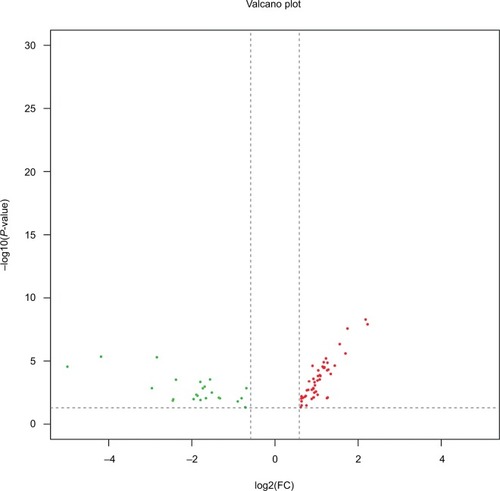
Identification of miRNAs correlated with the survival of CESC patients
To identify the association between miRNAs and the survival of CESC patients, the overall survival times of 275 CESC patients in the TCGA dataset were analyzed by the Kaplan–Meier method and log-rank tests. The results showed that patients with high hsa-miR-508 or hsa-miR-526b levels had a longer overall survival time than did those with low hsa-miR-508 level or hsa-miR-526b levels (log-rank test: P=0.006, 0.003), as shown in . The correlation of hsa-miR-509-2 level with overall survival time in the 275 CESC patients was not significant. The miRNA expression data are shown in and .
Table 2 Three downregulated miRNAs in early-stage CESC patients with lymph node metastases
Figure 3 Kaplan–Meier survival curves of the expression of the three miRNAs of interest in CESC.
Notes: Kaplan–Meier survival curves show that low miRNA expression was associated with poor survival in CESC patients. Patients were divided into high and low levels according to the median of each miRNA. (A) hsa-miR-508; (B) hsa-miR-509-2; (C) hsa-miR-526b.
Abbreviation: CESC, cervical cancer.

Figure 4 Differential expression of the three miRNAs of interest in LNM(+) and LNM(−) patients.
Notes: (A) The expression levels of hsa-miR-508 in LNM(+) and LNM(−) patients. (B) The expression levels of hsa-miR-509-2 in LNM(+) and LNM(−) patients. (C) The expression levels of hsa-miR-526b in LNM(+) and LNM(−) patients. The expression level values were calculated using log2-transformed values.
Abbreviation: LNM, lymph node metastasis.

Univariate and multivariate Cox regression analyses in CESC patients
The clinical features of age, smoking history, clinical stage, tumor grade, and metastasis were considered in the univariate and multivariate Cox regression analyses to analyze the prognosis of CESC patients. The univariate analysis suggested that there was a significant association between overall survival time and clinical stage (HR: 2.329, 95% CI: 1.423–3.812, P=0.001), hsa-miR-508 (HR: 0.511, 95% CI: 0.315–0.828, P=0.006), and hsa-miR-526b (HR: 0.484, 95% CI: 0.294–0.795, P=0.004). No significant association was observed between overall survival time and age, smoking history, tumor grade, or metastasis. The multivariate analysis suggested that clinical stage (HR: 2.368, 95% CI: 1.414–3.967, P=0.001), hsa-miR-508 (HR: 0.496, 95% CI: 0.298–0.826, P=0.007), hsa-miR-509-2 (HR: 0.596, 95% CI: 0.363–0.980, P=0.041), and hsa-miR-526b (HR: 0.591, 95% CI: 0.350–0.996, P=0.048) were prognostic factors for CESC ().
Table 3 Univariate and multivariate Cox regression analyses in CESC patients
Functional implication of prognostic miRNA signatures
To further analyze the mechanisms of these miRNAs (hsa-miR-508, hsa-miR-509-2, and hsa-miR-526b) in CESC, we used miRWalk2.0, which identifies overlapping genes between miRanda, PITA, and the Targetscan databases to predict target genes. Then, we performed functional enrichment analysis with GO and KEGG using BiNGO and DAVID. The GO BP terms were remarkably enriched in epithelial cell development, regulation of cell shape, neuronal migration, and so on. For the GO cellular component (CC) terms, the target genes were concentrated in the cortical actin cytoskeleton, postsynaptic density, and so on. The molecular function (MF) category was focused on steroid hormone receptor activity, NOTCH binding, and so on (, ). In addition, the KEGG pathways were mostly enriched in cancer pathways, including the MAPK, cAMP, PI3K/Akt, mTOR, and estrogen signaling pathways (, ). The GO network was illustrated as an interaction network using the Cytoscape plug-in BiNGO, which maps the main functional categories of a given gene set in the GO hierarchy. As shown in , the regulation of cellular and primary metabolic processes was important in the BP network. In the CC network, the cell and intracellular components were in core positions (). Additionally, the ion, cation, metal ion, and zinc ion binding components were significant in the MF network ().
Table 4 GO terms enriched in target genes
Table 5 KEGG pathways enriched in target genes
Figure 6 KEGG pathways for the target genes of three miRNAs using DAVID.
Abbreviations: HCM, hypertrophic cardiomyopathy; KEGG, Kyoto Encyclopedia of Genes and Genomes.
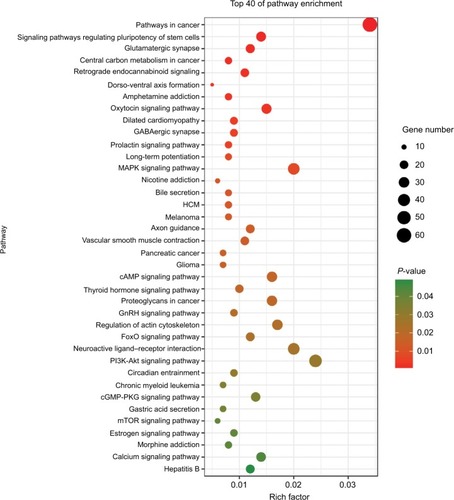
Figure 7 The BP network showed as an interaction network using the Cytoscape plug-in BiNGO.
Notes: Color depth represented the degree of enrichment of GO terms. The significance of enrichment is represented by yellow color (P<0.05).
Abbreviations: BP, biological process; GO, gene ontology.
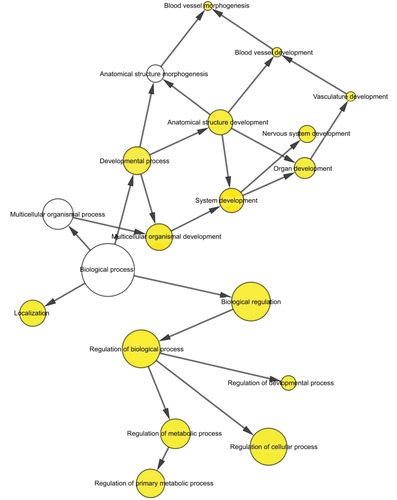
Selection of hub proteins
The PPI network of target genes was analyzed according to the STRING database, including 956 nodes and 3,448 edges. Then, we used the MCODE plug-in in Cytoscape software to build the core module, which consist of 29 nodes and 95 edges (MCODE score: 7.000). The highly connected node with the highest height is considered the hub protein of the network. A total of 29 proteins were selected as the most significant hub proteins, including TP53 (a target of hsa-miR-508, hsa-miR-509-2, and hsa-miR-526b), MMP1 (a target of hsa-miR-509-2 and hsa-miR-526b), NOTCH1 (a target of hsa-miR-509-2), SMAD4 (a target of hsa-miR-508 and hsa-miR-526b), and NFKB1 (a target of hsa-miR-508), which might be associated with LNM in early-stage CESC ().
Discussion
CESC is one of the major primary gynecological tumors that affect women’s health. In developing countries, the 5-year overall survival rate is only 46%, which is far lower than that of developed countries.Citation2 LNM in the early stage affects the prognosis of CESC.Citation6 Therefore, it is necessary to identify prognostic miRNAs and determine their molecular mechanisms. In this study, we found that hsa-miR-508, hsa-miR-509-2, and hsa-miR-526b were downregulated in LNM(+) patients and could effectively evaluate the prognosis of CESC. Moreover, we explained the potential mechanisms via GO and KEGG enrichment and PPI network analyses of target genes.
As far as we know, there is limited research on the role of these three miRNAs (hsa-miR-508, hsa-miR-509-2, and hsa-miR-526b) in CESC. We first demonstrated that three miRNAs were downregulated in early-stage CESC LNM(+) patients and influenced the prognosis of CESC through bio-informatics analysis. In a recent study, Liu et al reported that hsa-miR-508 is an independent, protective prognostic factor of glioma, and functional tests confirmed that overexpression of hsa-miR-508 inhibits the migration of glioma cells, which was similar to the results of our study.Citation31 In gastric cancer, hsa-miR-508 inhibits the invasion of gastric cancer cells by targeting S-phase kinase-associated protein 2.Citation32 Huang et al also found that hsa-miR-508 expression is downregulated in gastric carcinogenesis cell lines and plays a major role as a tumor suppressor gene in gastric cancer.Citation33 Moreover, miRNA microarray profiling showed that hsa-miR-508 expression is downregulated in lymph node metastatic tissues.Citation34 In addition, Zhai et al indicated that hsa-miR-508 inhibits renal cell cancer cell invasion and migration.Citation35 hsa-miR-509 serves as a cancer suppressor gene in various cancers, such as lung cancer, breast cancer, renal cell cancer, and pancreatic cancer.Citation36–Citation40 hsa-miR-509 can inhibit tumor cell invasion and migration through target genes. Using bioinformatics analysis, hsa-miR-509 was found to be downregulated in breast cancer and brain metastasis compared to primary cancer and was shown to play a role in suppressing brain metastasis by regulating the RhoC-TNF-α network in both in vivo and in vitro experiments.Citation41 Additionally, low expression levels of hsa-miR-509 were associated with poor outcomes in pancreatic cancer patients.Citation39 hsa-miR-526b can inhibit tumor progression by targeting MMP1.Citation42 Meanwhile, Zhang et al found that hsa-miR-526b is downregulated in lung cancer, and low expression was associated with poor clinical outcomes through the p53/p21 pathway.Citation43 In colon cancer, hsa-miR-526b was reported to be downregulated in metastatic tissue and to inhibit cell proliferation and invasion by regulating the hub gene HIF-1α.Citation44 Liu et al observed that low hsa-miR-526b expression correlates with poor prognosis in hepatocellular carcinoma and enhanced lung metastasis in mouse lungs via the ERK pathway.Citation45
To investigate the mechanism of LNM in early-stage CESC, we conducted KEGG pathway and GO annotation enrichment analyses and PPI network analyses on three miRNA target genes. Pathway enrichment analysis showed that the target genes were mainly enriched in pathways in cancer, such as MAPK, cAMP, PI3K/Akt, and mTOR pathways. The MAPK pathway has been reported to play a role in the tumor progression of CESC.Citation13,Citation46,Citation47 Zhang et al found that the MAPK pathway was associated with LNM in head and neck cancer.Citation48 Research has shown that the Akt/ mTOR pathway is activated in medullary thyroid carcinoma with lymph node metastases.Citation49 In the coexpression regulatory network of target genes, multiple studies have shown that a TP53 gene mutation increases the risk of CESC.Citation50–Citation52 MMP1 has been associated with LNM in esophageal squamous cell cancer,Citation53 lung cancer,Citation54 and gastric cancer.Citation55 Liu et al reported that MMP1 promotes esophageal squamous cell carcinoma cell migration and invasion via the PI3K/ Akt pathway.Citation53 In CESC, NOTCH1 has been associated with LNM, and high expression of NOTCH1 indicates a poor prognosis in patients.Citation56 At the same time, Park et al found that NOTCH1 could be a molecular marker of LNM in papillary thyroid cancer.Citation57 In pancreatic and colorectal cancer, SMAD4 was found to be associated with LNM and survival.Citation58,Citation59 Another gene in the network, NFKB1, was reported to increase the risk of LNM in gastric cancer and oral cancer.Citation60,Citation61 These results suggest that the target genes of these three miRNAs play a significant role in LNM in early-stage CESC.
However, there are some deficiencies in our research at present. Although the three miRNAs were downregulated in LNM(+) patients according to the bioinformatics analyses, the original samples need additional validation. Functional tests need to be conducted, and the mechanism of LNM in early-stage CESC needs further study. Our group is currently pursuing some of these research goals.
Conclusion
Using bioinformatics analysis, we have shown for the first time that three miRNAs were downregulated in early-stage CESC LNM(+) patients and are potential prognostic indicators for CESC. In addition, five central genes (TP53, MMP1, NOTCH1, SMAD4, and NFKB1) were found to be directly or indirectly involved in LNM in early-stage CESC. Taken together, the results of the present study suggest that hsa-miR-508, hsa-miR-509-2, and hsa-miR-526b may be potential new diagnostic and prognostic markers for CESC in the future.
Acknowledgments
The work was financially supported by grant from the National Natural Science Foundation of China (grant no. 81360440 and 81660563). The work was done at Department of Research, Affiliated Tumor Hospital of Guangxi Medical University.
Supplementary material
Table S1 Differentially expressed microRNAs in LNM(+) and LNM(−) patients
Disclosure
The authors report no conflicts of interest in this work.
References
- SiegelRLMillerKDJemalACancer statistics, 2017CA Cancer J Clin201767173028055103
- TorreLAIslamiFSiegelRLWardEMJemalAGlobal cancer in women: burden and trendsCancer Epidemiol Biomarkers Prev201726444445728223433
- XuZZhouYShiFInvestigation of differentially-expressed microRNAs and genes in cervical cancer using an integrated bioinformatics analysisOncol Lett20171342784279028454467
- PoudyalDHermanAAdelsbergerJWA novel microRNA, hsa-miR-6852 differentially regulated by interleukin-27 induces necrosis in cervical cancer cells by downregulating the FoxM1 expressionSci Rep20188190029343703
- GaoCZhouCZhuangJMicroRNA expression in cervical cancer: novel diagnostic and prognostic biomarkersJ Cell Biochem201811987080709029737570
- NanthamongkolkulKHanprasertpongJPredictive factors of pelvic lymph node metastasis in early-stage cervical cancerOncol Res Treat201841419419829562222
- TaarnhøjGAChristensenIJLajerHRisk of recurrence, prognosis, and follow-up for Danish women with cervical cancer in 2005–2013: a national cohort studyCancer2018124594395129211304
- ZhouJZhangWWWuSGThe impact of examined lymph node count on survival in squamous cell carcinoma and adenocarcinoma of the uterine cervixCancer Manag Res2017931532228761376
- FlemingNDFrumovitzMSchmelerKMSignificance of lymph node ratio in defining risk category in node-positive early stage cervical cancerGynecol Oncol20151361485325451695
- HaMKimVNRegulation of microRNA biogenesisNat Rev Mol Cell Biol201415850952425027649
- LewisBPBurgeCBBartelDPConserved seed pairing, often flanked by adenosines, indicates that thousands of human genes are microRNA targetsCell20051201152015652477
- HeLHannonGJMicroRNAs: small RNAs with a big role in gene regulationNat Rev Genet20045752253115211354
- LiZHLiLKangLPWangYMicroRNA-92a promotes tumor growth and suppresses immune function through activation of MAPK/ERK signaling pathway by inhibiting PTEN in mice bearing U14 cervical cancerCancer Med20187731183131
- WangFShanSHuoYMiR-155-5p inhibits PDK1 and promotes autophagy via the mTOR pathway in cervical cancerInt J Biochem Cell Biol201899919929627439
- LiGCCaoXYLiYNMicroRNA-374b inhibits cervical cancer cell proliferation and induces apoptosis through the p38/ERK signaling pathway by binding to JAM-2J Cell Physiol201823397379739029575013
- DongJWangQLiLXiao-JinZUpregulation of long non-coding RNA small nucleolar RNA host gene 12 contributes to cell growth and invasion in cervical cancer by acting as a sponge for MiR-424-5pCell Physiol Biochem20184552086209429533945
- GerettoMPullieroARosanoCZhabayevaDBersimbaevRIzzottiAResistance to cancer chemotherapeutic drugs is determined by pivotal microRNA regulatorsAm J Cancer Res2017761350137128670496
- WangWTZhaoYNYanJXDifferentially expressed microRNAs in the serum of cervical squamous cell carcinoma patients before and after surgeryJ Hematol Oncol20147624405714
- YuJWangYDongRHuangXDingSQiuHCirculating microRNA-218 was reduced in cervical cancer and correlated with tumor invasionJ Cancer Res Clin Oncol2012138467167422237456
- GuelfiGCochettiGStefanettiVNext generation sequencing of urine exfoliated cells: an approach of prostate cancer microRNAs researchSci Rep201881711129740090
- BezrookoveVNosratiMMillerJRRole of elevated PHIP copy number as a prognostic and progression marker for cutaneous melanomaClin Cancer Res201824174119412529776954
- ZillOABanksKCFaircloughSRThe landscape of actionable genomic alterations in cell-free circulating tumor DNA from 21,807 advanced cancer patientsClin Cancer Res201824153528353829776953
- LiuMZhangLLiHIntegrative epigenetic analysis reveals therapeutic targets to the DNA methyltransferase inhibitor guadecitabine (SGI-110) in hepatocellular carcinomaHepatology20186841412142829774579
- RobinsonMDMccarthyDJSmythGKedgeR: a bioconductor package for differential expression analysis of digital gene expression dataBioinformatics201026113914019910308
- DweepHGretzNmiRWalk2.0: a comprehensive atlas of microRNA– target interactionsNat Methods201512869726226356
- HuangDawShermanBTLempickiRASystematic and integrative analysis of large gene lists using DAVID bioinformatics resourcesNat Protoc200941445719131956
- MaereSHeymansKKuiperMBiNGO: a Cytoscape plugin to assess overrepresentation of gene ontology categories in biological networksBioinformatics200521163448344915972284
- SzklarczykDMorrisJHCookHThe STRING database in 2017: quality-controlled protein-protein association networks, made broadly accessibleNucleic Acids Res201745D1D362D36827924014
- BaderGDHogueCWAn automated method for finding molecular complexes in large protein interaction networksBMC Bioinformatics20034212525261
- ShannonPMarkielAOzierOCytoscape: a software environment for integrated models of biomolecular interaction networksGenome Res200313112498250414597658
- LiuYHLiBMengFGQiuLMiR-508-5p is a prognostic marker and inhibits cell proliferation and migration in gliomaEur Rev Med Pharmacol Sci2017211768128121353
- DuanXBaiJWeiJLiZLiuXXuGMicroRNA-508-5p suppresses metastasis in human gastric cancer by targeting S-phase kinase-associated protein 2Mol Med Rep20171622163217128627698
- HuangTKangWZhangBmiR-508-3p concordantly silences NFKB1 and RELA to inactivate canonical NF-κB signaling in gastric carcinogenesisMol Cancer201615926801246
- WangZWangJYangYLoss of has-miR-337-3p expression is associated with lymph node metastasis of human gastric cancerJ Exp Clin Cancer Res2013327624422944
- ZhaiQZhouLZhaoCIdentification of miR-508-3p and miR-509-3p that are associated with cell invasion and migration and involved in the apoptosis of renal cell carcinomaBiochem Biophys Res Commun2012419462162622369946
- WangPDengYFuXMiR-509-5p suppresses the proliferation, migration, and invasion of non-small cell lung cancer by targeting YWHAGBiochem Biophys Res Commun2017482493594127894843
- ZhangGLiuZHanYWangXYangZOverexpression of miR-509 increases apoptosis and inhibits invasion via suppression of tumor necrosis factor-α in triple-negative breast cancer Hs578T cellsOncol Res201624423323827656833
- ZhangWBPanZQYangQSZhengXMTumor suppressive miR-509-5p contributes to cell migration, proliferation and antiapoptosis in renal cell carcinomaIr J Med Sci2013182462162723619562
- HiramotoHMuramatsuTIchikawaDmiR-509-5p and miR-1243 increase the sensitivity to gemcitabine by inhibiting epithelial-mesenchymal transition in pancreatic cancerSci Rep201771400228638102
- SongYHWangJNieGMicroRNA-509-5p functions as an anti-oncogene in breast cancer via targeting SOD2Eur Rev Med Pharmacol Sci201721163617362528925482
- XingFSharmaSLiuYmiR-509 suppresses brain metastasis of breast cancer cells by modulating RhoC and TNF-αOncogene201534374890490025659578
- KimKHJungJYSonEDShinDWNohMLeeTRmiR-526b targets 3’ UTR of MMP1 mRNAExp Mol Med201547e17826292968
- ZhangZYFuSLXuSQBy downregulating Ku80, hsa-miR-526b suppresses non-small cell lung cancerOncotarget2015631462147725596743
- ZhangRZhaoJXuJWangJJiaJmiR-526b-3p functions as a tumor suppressor in colon cancer by regulating HIF-1αAm J Transl Res2016862783278927398161
- LiuXYangLTuJMicroRNA-526b servers as a prognostic factor and exhibits tumor suppressive property by targeting Sirtuin 7 in hepatocellular carcinomaOncotarget2017850877378774929152116
- HuaFFLiuSSZhuLHMiRNA-338-3p regulates cervical cancer cells proliferation by targeting MACC1 through MAPK signaling pathwayEur Rev Med Pharmacol Sci201721235342535229243777
- TaoLZhangCYGuoLMicroRNA-497 accelerates apoptosis while inhibiting proliferation, migration, and invasion through negative regulation of the MAPK/ERK signaling pathway via RAF-1J Cell Physiol2017
- ZhangXHuntJLLandsittelDPCorrelation of protease-activated receptor-1 with differentiation markers in squamous cell carcinoma of the head and neck and its implication in lymph node metastasisClin Cancer Res200410248451845915625067
- TamburrinoAMolinoloAASalernoPActivation of the mTOR pathway in primary medullary thyroid carcinoma and lymph node metastasesClin Cancer Res201218133532354022753663
- KlugSJRessingMKoenigJTP53 codon 72 polymorphism and cervical cancer: a pooled analysis of individual data from 49 studiesLancet Oncol200910877278419625214
- OjesinaAILichtensteinLFreemanSSLandscape of genomic alterations in cervical carcinomasNature2014506748837137524390348
- TorneselloMLBuonaguroLBuonaguroFMMutations of the TP53 gene in adenocarcinoma and squamous cell carcinoma of the cervix: a systematic reviewGynecol Oncol2013128344244823168175
- LiuMHuYZhangMFMMP1 promotes tumor growth and metastasis in esophageal squamous cell carcinomaCancer Lett201637719710427130665
- FangSJinXWangRPolymorphisms in the MMP1 and MMP3 promoter and non-small cell lung carcinoma in North ChinaCarcinogenesis200526248148615528217
- KamataIIshikawaYAkishima-FukasawaYSignificance of lymphatic invasion and cancer invasion-related proteins on lymph node metastasis in gastric cancerJ Gastroenterol Hepatol20092491527153319383080
- YousifNGSadiqAMYousifMGAl-MudhafarRHAl-BaghdadiJJHadiNNotch1 ligand signaling pathway activated in cervical cancer: poor prognosis with high-level JAG1/Notch1Arch Gynecol Obstet2015292489990425842263
- ParkHSJungCKLeeSHNotch1 receptor as a marker of lymph node metastases in papillary thyroid cancerCancer Sci2012103230530922118425
- JiangHHeCGengSRhoT1 and Smad4 are correlated with lymph node metastasis and overall survival in pancreatic cancerPLoS One201277e4223422860091
- TanakaTWatanabeTKazamaYLoss of Smad4 protein expression and 18qLOH as molecular markers indicating lymph node metastasis in colorectal cancer – a study matched for tumor depth and pathologyJ Surg Oncol2008971697317786972
- ArisawaTTaharaTShiroedaHFunctional promoter polymorphisms of NFKB1 influence susceptibility to the diffuse type of gastric cancerOncol Rep20133063013301924101096
- LinSCLiuCJYehWILuiMTChangKWChangCSFunctional polymorphism in NFKB1 promoter is related to the risks of oral squamous cell carcinoma occurring on older male areca (betel) chewersCancer Lett20062431475416387424

